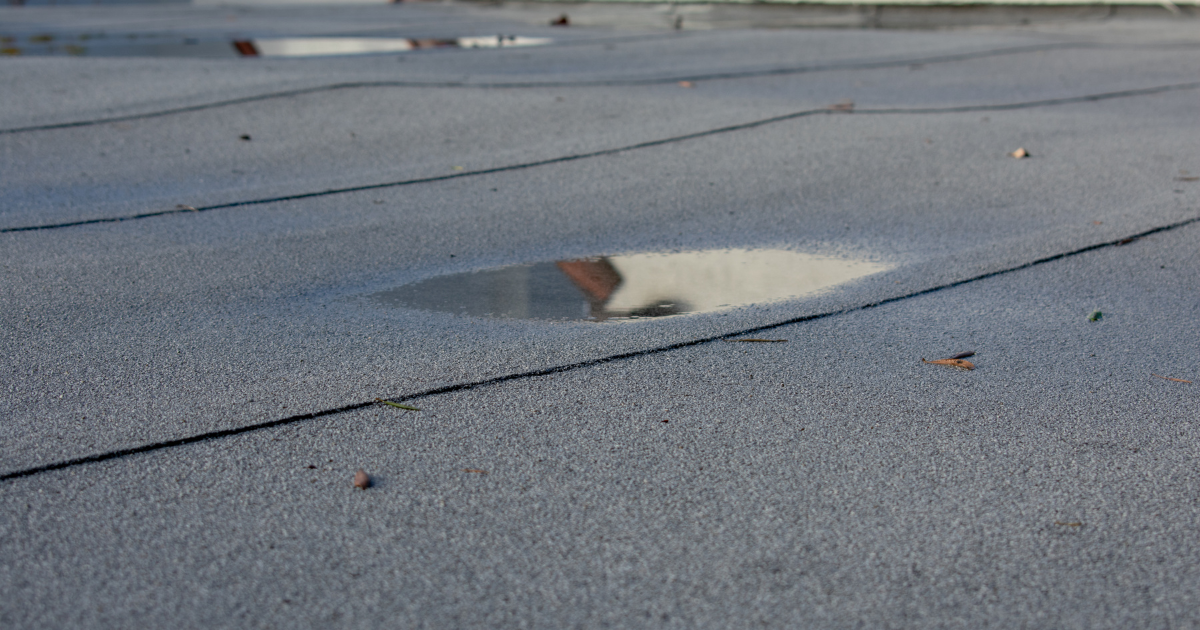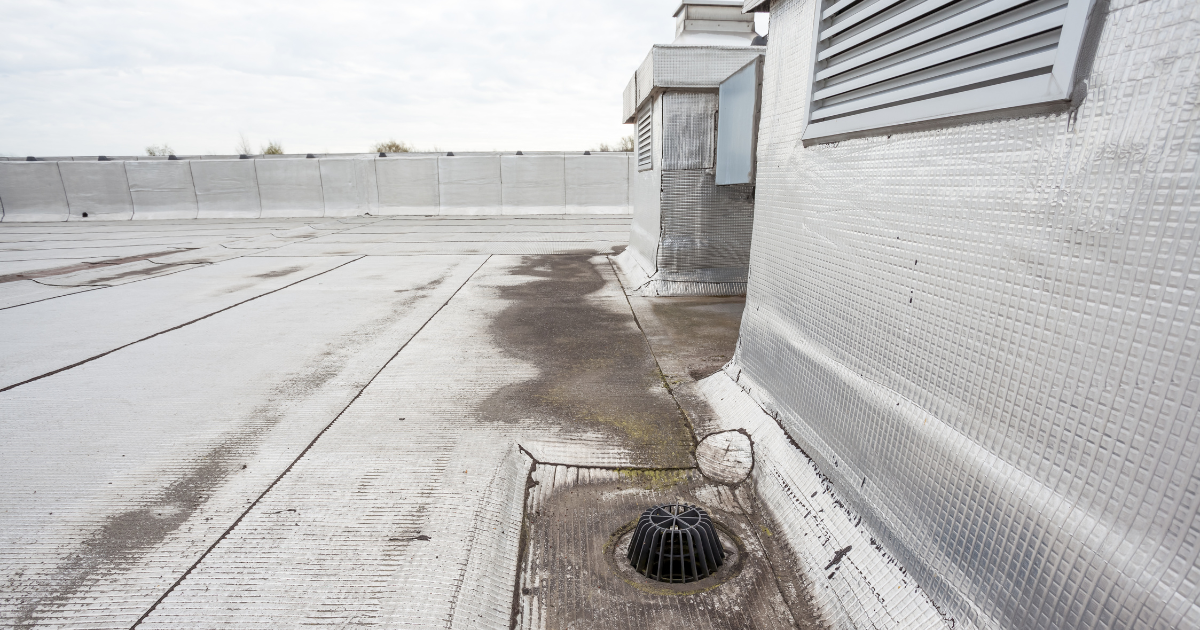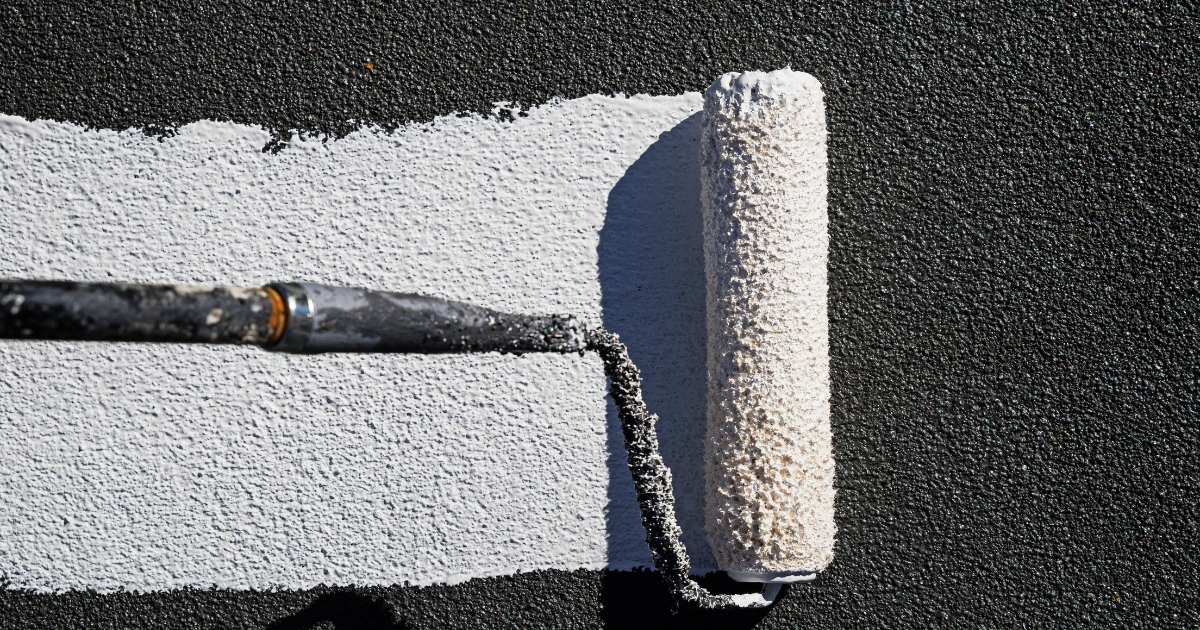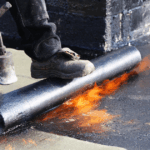
You’ve probably done this before: after a storm, you walk the perimeter of your building and everything looks fine. But as you climb up to the roof, you notice shallow pools shimmering under the cloudy sky. At first glance, you might think they’ll evaporate in a day or two, but in reality, that water can quietly eat away at your roofing system, overload your structure, and eventually force repairs that run into the tens (or even hundreds) of thousands of dollars.
We understand – the fear of sudden, unexpected costs keeps many property managers up at night. But here’s the good news: ponding water on flat roof isn’t inevitable. Let’s explore together how ponding water damages roofs, why pooling issues are so common in cities like Detroit, and what practical steps you can take to prevent costly restorations. You’ll see that with proactive roof maintenance and the right drainage solutions, you can take control and keep your building safe.
Understanding Ponding Water on Flat Roof
For many facility managers, the first time they hear about this issue is after a costly service call. What looks like a harmless puddle after a storm is actually a red flag that your roof isn’t draining the way it should. The longer water lingers, the more pressure it puts on your building’s structure, insulation, and overall performance. By understanding how and why ponding occurs, you can spot early warning signs and take action before minor pooling turns into major structural concerns.
What Counts as Ponding?
According to Professional Roofing, “ponding water for short durations is unavoidable and considered acceptable by NRCA … but ponding water in excess of 48 hours can be detrimental to the roof assembly.”
In other words, the industry benchmark’s message is clear: when water stays on a flat roof beyond the expected drying window, especially in climates like Detroit, it points to a drainage issue that needs immediate evaluation.
Why Flat Roofs Are Prone to It
Flat roofs aren’t actually flat – they’re engineered with a very subtle pitch, often just a quarter inch per foot, to guide rainwater toward drains or scuppers. This design detail may seem minor, but it’s critical for preventing water from accumulating. When that slope is off even slightly, water no longer travels as intended and begins to pool in low spots.
The drainage system also plays a huge role. Internal drains, gutters, and scuppers must remain clear of debris, or they quickly become bottlenecks that trap water instead of moving it off the roof. When these issues combine, standing water on commercial roofing is practically inevitable. Once water finds a place to sit, it often returns to that spot after every storm, gradually turning a minor nuisance into a long-term threat to the roof system.
Early Warning Signs
One of the first visible signs of trouble is discoloration on the roof surface. Dark stains or algae growth indicate that water is lingering longer than it should, creating a breeding ground for organic matter. These marks reveal that water is finding permanent resting spots instead of draining away.
Another red flag is the presence of low areas, or depressions, that collect water after every rainfall. These dips often form slowly over time as roofing materials settle under constant pressure. Once established, they become repeat offenders: no matter how light or heavy the rain, water gravitates back to those same spots, increasing the risk of leaks and structural stress.
These warning signs may seem small, but the structural consequences are anything but.
Structural Risks of Ponding Water
What looks like a shallow puddle can actually weigh thousands of pounds when spread across a large surface. Over time, that added weight stresses the membrane, presses down on the roof deck, weakens insulation, and compromises the building’s structure. Left unaddressed, this standing water slowly transforms from a maintenance concern into a serious safety risk, with the potential to shorten roof lifespan, drive up repair costs, and even threaten the integrity of the entire building.
Added Weight on the Roof Deck
Water is deceptively heavy. Just one inch of ponding water adds over 500 pounds per 100 square feet. On a large commercial building, that weight multiplies into several tons pressing down on the roof deck. At first, the structure may seem to hold up, but over time the stress causes the deck to sag in subtle ways. Plus, once those low spots form, they attract even more water during the next rainfall, creating a self-feeding cycle of pooling and sagging.
Insulation Breakdown
When moisture seeps through the membrane and saturates the insulation below, the material quickly loses its thermal resistance, or R-value. That means that a roof that once kept heating and cooling costs under control now forces HVAC systems to work overtime, raising utility bills month after month. Beyond efficiency losses, wet insulation also becomes a breeding ground for mold, which spreads through the building and creates health risks for occupants. In severe cases, entire sections of insulation must be replaced – a costly process that could have been avoided with proper drainage.
Roof Membrane Damage
Prolonged exposure to ponding water on flat roof surfaces slowly wears away the protective membrane. At first, the damage is almost invisible: a small bubble here, a bit of softening there. But as trapped vapor expands beneath the surface, blisters begin to form, creating weak spots that can’t withstand pressure. Over time, those weak spots give way to cracks, especially at seams and flashing where the roof is already vulnerable. What begins as a minor surface issue gradually escalates into an open invitation for leaks, and once water penetrates the membrane, the damage doesn’t stay contained to the roof – it spreads into insulation, decking, and even the interior of the building.
Safety Concerns
Perhaps the most alarming risk of flat roof water pooling issues is what happens when sagging and stress go unchecked. Over time, the roof structure weakens to the point where it can no longer bear the combined load of water, snow, and rooftop equipment. The result can be partial collapse, forcing a facility shutdown, or in extreme cases, a complete roof failure. For any property manager, the thought of evacuating tenants or halting operations due to roof collapse is a nightmare scenario – and a reminder that ponding water should never be ignored.
Once the roof structure weakens, the next stage of damage is usually hidden until it’s too late: leaks.

How Ponding Water Leads to Interior Leaks
A flat roof rarely fails all at once – the damage usually starts small. When ponding water on flat roof surfaces lingers day after day, it gradually finds its way past the protective layers meant to keep your building dry. At first, the leaks are so subtle they go unnoticed, but over time, they make their way inside, staining ceilings, weakening insulation, and disrupting operations.
How Water Gets In
When water lingers after a storm, it doesn’t just sit harmlessly on the surface – it steadily presses against the roof. That constant pressure works its way into the smallest vulnerabilities, and once moisture begins to creep through these weak points, what starts as a few drops can quickly grow into a steady flow, turning minor imperfections into serious leaks.
What Leaks Mean Inside
Once water breaks through the roof membrane, the impact is felt inside the building. Ceiling stains are often the first visible sign, frustrating tenants and eroding confidence in the property’s upkeep. If left unchecked, damp conditions encourage mold growth, which spreads quickly and creates health concerns for employees and visitors. And the danger doesn’t stop there: when leaks reach electrical systems, they introduce serious hazards, from short circuits to fire risks.
The True Cost of Leaks
One leak on its own might already cost thousands to repair, especially if it damages insulation, drywall, or ceiling tiles. But when ponding water creates multiple leaks across a building, the impact multiplies quickly. Each drip introduces new repair bills, while the hidden costs (lost productivity, temporary closures, and tenant complaints) begin to pile up. Regulatory concerns may also come into play, particularly if mold growth or electrical hazards put occupants at risk. And beneath it all, the structure itself absorbs repeated damage, leading to sagging, rust, or wood rot that demand even more extensive roof restoration.
“Most clients assume ponding water is just part of owning a flat roof. In truth, it’s a drainage issue with real solutions. Once we address it, the risk of major repairs drops dramatically.” – Rick Dodaj, Founder of Silicoat Roofing.
Of course, fixing ponding water costs money. But how does that compare to waiting until repairs are unavoidable?
The ROI of Fixing Ponding Water Early
It’s easy to put off addressing ponding water on flat roof systems, especially if the damage isn’t immediately visible. But waiting almost always costs more in the long run. A relatively small investment in drainage improvements today can prevent structural deterioration, reduce energy bills, and add years of service life to your roof. Beyond the dollars saved, fixing the problem early also protects tenant satisfaction, minimizes operational disruptions, and gives facility managers peace of mind. In short, proactive solutions deliver returns that far outweigh the upfront cost.
Cost Savings
Addressing ponding water before damage sets in can save staggering amounts of money. Structural restorations caused by prolonged pooling often run well over $100,000 once decking, insulation, and interior finishes are involved. By contrast, drainage improvements are a fraction of that cost. Keeping insulation dry also pays dividends every month: when insulation maintains its R-value, HVAC systems don’t need to work overtime – that’s money back in your operating budget year after year, not just a one-time savings.
Extended Roof Lifespan
A well-maintained roof is designed to last decades, but flat roof water pooling issues shorten that timeline significantly. Standing water accelerates wear on membranes, seams, and coatings, forcing premature replacement. By investing in proper drainage, property managers can add 10-15 years of service life to a roof system. Spreading the cost of replacement over a longer period means better predictability in capital planning and fewer disruptive construction projects in the future.
Peace of Mind
Beyond dollars and cents, early action offers something less tangible but just as valuable:confidence in your roof’s performance. Facility managers no longer have to worry about sagging spots after a storm, surprise leaks during tenant walkthroughs, or emergency commercial roof repair in the middle of winter. Knowing that your roof can withstand Detroit’s weather without recurring issues allows you to focus on operations, tenants, and growth instead of constant damage control.
With prevention so much cheaper, many facility managers ask practical questions about what counts as ponding and when action is needed.

Common Questions About Ponding Water on Flat Roof
How long can ponding water sit on a flat roof before it’s a problem?
Anything beyond 48 hours is considered a drainage failure that requires inspection.
Is ponding water on flat roof always a sign of bad installation?
Not always. Age, structural shifting, and debris can cause new pooling issues even on well-installed roofs.
Can coatings fix ponding water?
Coatings protect membranes but don’t resolve slope or drainage failures. A full solution usually requires drainage improvements.
Why are Detroit roofs especially vulnerable?
The city’s freeze-thaw cycles cause expansion and cracking, making drainage solutions critical for long-term protection.
Acting Now Saves Money Later
Ponding water on flat roof may start as a small puddle, but it leads to costly structural damage, higher energy bills, and premature roof failure. The good news is that these problems are preventable with expert inspection and drainage design.
Silicoat Roofing is dedicated to solving flat roof water pooling issues with proven Detroit roof drainage solutions that safeguard your building and extend its lifespan.
Don’t wait for ponding water to become a crisis. Contact us today to schedule your inspection and secure your building’s future.
About the Author
Rick Dodaj is the founder and CEO of Silicoat Roofing, specializing in commercial roofing solutions that protect businesses and their investments. With extensive experience in commercial roofing, Rick leads a team dedicated to providing cost-effective, long-lasting roofing solutions. Connect with him on LinkedIn to learn more about commercial roof maintenance and protection strategies.


 Previous Post
Previous Post Next Post
Next Post